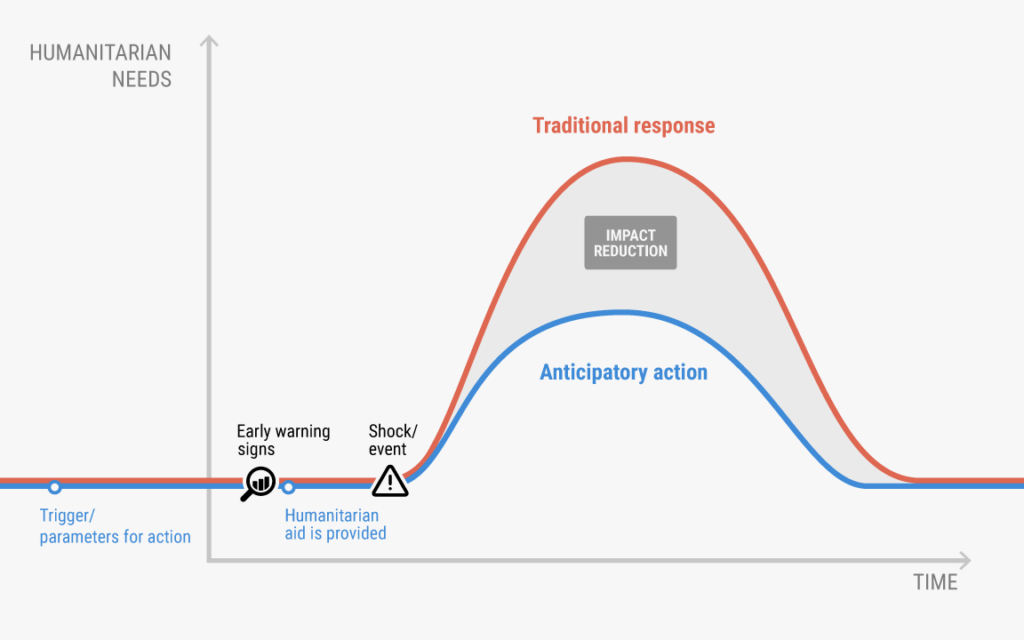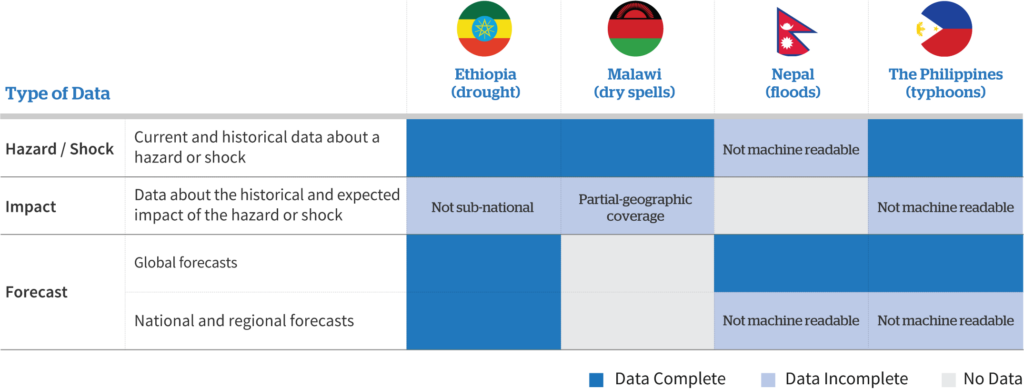Share
In The State of Open Humanitarian Data 2022, the Centre assesses the availability of data across humanitarian crises. This year’s report includes a section on the data needed for anticipatory action, which we have excerpted below. A priority for the coming years will be improving access to forecast and impact data for hazards and shocks. Making progress will be essential for expanding anticipatory action frameworks to more countries with humanitarian operations.
Anticipatory action enables humanitarian organizations to provide assistance before a shock occurs, reducing the impact of a crisis on the lives of affected people. Since early 2020, OCHA has been testing the practicalities of anticipatory action through pilots in 12 countries. Each pilot has an anticipatory action framework with three elements: a forecast-based trigger mechanism embedded in a decision-making process (the model); a pre-agreed action plan (the delivery); and pre-arranged finance (the money, in this case from the UN Central Emergency Response Fund).
We have been supporting this work through the development of the trigger mechanisms. A trigger mechanism translates the characteristics of a hazard or a shock (e.g., drought or flood) and its impact (e.g., food insecurity or damaged housing) into technical specifications. These specifications are the basis for the action plan’s preemptive response.
Triggers can include both observational data, such as water levels, and predictive elements, such as flood forecasts. A trigger is designed to provide partners with a window of opportunity to take action while balancing the uncertainty of the forecasts.
Designing a trigger requires access to three types of data:
1. Current and historical data about the hazard;
2. Data about the historical and expected impact of the hazard and shock; and
3. Hazard forecast data.
Despite progress in filling data gaps in 2021, the availability and usability of this type of data remains a major barrier to implementing anticipatory action in many humanitarian contexts. There has been sufficient data for the existing OCHA pilots but expanding anticipatory action to new humanitarian operations will be challenging without improvements to the data landscape.
Here we provide a closer look at the data needed for developing triggers based on our experience with several countries, including Ethiopia, Malawi, Nepal and the Philippines. While we touch on the DRC and Mozambique, the work to anticipate cholera is ongoing so we have not included these countries in the data availability table.
1. Hazard Data
Current and historical data about a hazard is required to model the likelihood of the event occurring. This data includes weather and climate observations and disease surveillance, as well as lists of recorded historical events, which are often incomplete or hard to access.
In Ethiopia, for example, despite the number of actors producing early warning analysis for drought in the Horn of Africa, there is no consensus on the exact definition of what should be considered a drought. As a result, there was no agreed-upon reference list of historical drought years, which was needed to establish a trigger threshold and assess its performance.
Similarly, in Malawi, there was no reference dataset to understand the frequency and patterns of dry spells affecting the southern region of the country, primarily due to a lack of consensus around the definition of the shock. To fill this gap, we have analyzed and made available on HDX over 20 years of historical sub-national rainfall data to better understand when and where dry spells took place.
For anticipating cholera in the DRC and Mozambique, it was challenging to find datasets listing all past outbreaks. When the data was available, it was provided in multiple PDF reports, requiring significant effort to make it usable for analysis.
2. Impact Data
Data linking previous shocks to their impact on vulnerable populations is essential for the design of an anticipatory action trigger. With this data in hand, it is possible to model the expected impact of a future shock.
In the Philippines, historical data on housing damage from previous typhoons was foundational for developing an impact model based on forecasted typhoon tracks. In Nepal, the list of historical floods was estimated using data on water levels but it was difficult to estimate the severity of these events (i.e., the number of people affected or the houses destroyed by the flood). In Malawi, OCHA conducted a survey and interviews to better understand the impact of past dry spells.
Access to impact data is one of the main limitations in implementing anticipatory action in countries with humanitarian operations. There are consistent gaps in data on the impact of hazards on vulnerable populations. Even when this data is available, it is unlikely to be machine readable, sub-national and/or include relevant geographic coverage.
These findings correspond with the completeness levels of the affected areas sub-category in the HDX Data Grids, where 10 out of the 27 locations are missing data. Where this data does exist, it may only refer to a recent shock (i.e., a flood in South Sudan) or be part of a broader severity analysis conducted for the Humanitarian Needs Overview process.
3. Forecast Data
Current forecast data is provided globally, with projections for riverine floods, seasonal rainfall forecasts, or major storms; or at the regional and national level, with projections for specific countries or areas. In addition, historical forecasts are used to better understand model performance and the lead time that these models could provide as part of an anticipatory action plan.
Accessing forecast data in a machine-readable format is a challenge. In the Philippines, we relied on global data providers. In Nepal, national authorities provided qualitative flood early warning information, which had to be extracted and translated from social media and the Government’s website. The challenge can be even greater when looking for historical forecast data. It is either not available or has very limited geographic or temporal coverage. For Nepal, we found that national authorities did not keep a record of historical flood forecasts, which was needed to evaluate the forecasting skills and lead time of the model.
Improving Access to Hazard and Shock Data
The anticipatory action pilots have demonstrated the promise of getting ahead of crises before they escalate by using different analytical approaches to predict out-of-the-ordinary events and their projected impact on vulnerable people. This approach is enabled by the growing availability and quality of forecast data as well as the increasing awareness of humanitarian actors of the opportunities it provides.
Access to forecast, observational and impact data about hazards and shocks will be essential to expanding anticipatory action frameworks to more countries with humanitarian operations. To help humanitarian actors better assess the feasibility of anticipatory action in different contexts, the Centre is developing a checklist for trigger mechanisms. This will include data requirements in addition to other factors such as local capacity and monitoring.
Beyond anticipatory action, more robust weather and climate data is needed to understand the near and medium-term effects of the climate crisis on humanitarian operations. Access to relevant data and evidence about the humanitarian impacts of climate change is key to helping extend the annual time horizon humanitarians typically focus on.
To give momentum to these efforts, we will create a new category in the HDX Data Grids that includes the types of data detailed above. We will also work with researchers to fill known data gaps by developing reference lists of historical hazards and their impact for priority countries.
Contact us at centrehumdata@un.org if you have any feedback or if you would like to collaborate on research. You can always find the latest data availability information on the Overview of Data Grids page on HDX.

